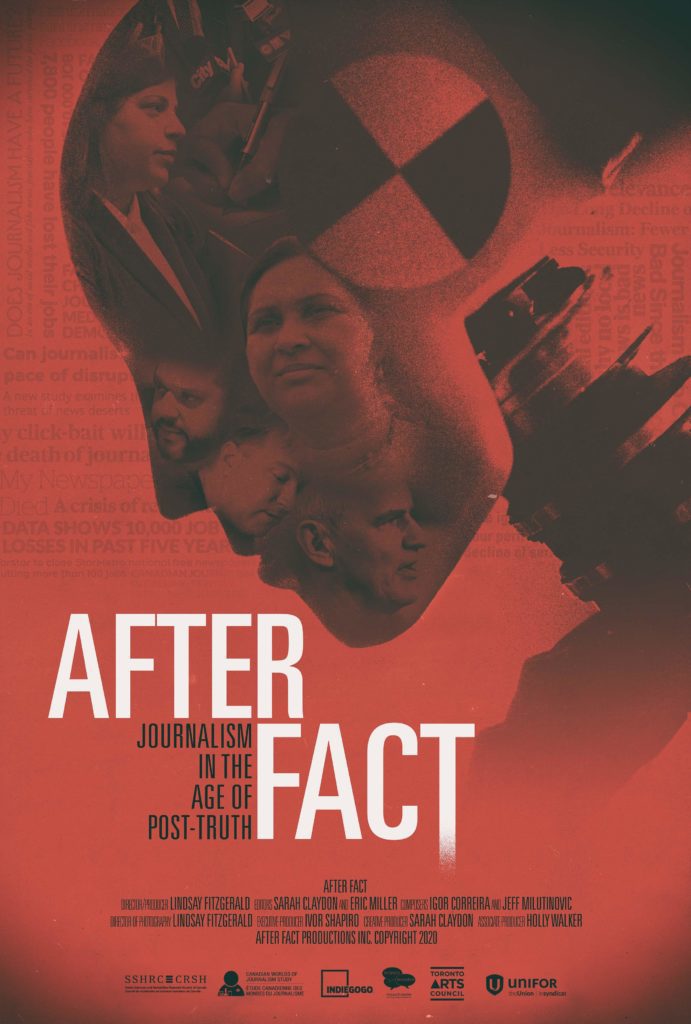Movie & More

Journalists at Work
Journalists at Work is a sequence of four educational units based on findings from our study and supported by scenes from the film, AFTER FACT (2020).
Each unit includes a suggested lesson plan, a specially selected movie clip, and customizable slides with key findings from the Canadian Worlds of Journalism Study (CWJS).
These materials are freely available to teachers and instructors anywhere. The slides and other teaching material can be adapted for a wide range of subject areas and educational levels. The four units are:
1. Where are Those Facts? Journalism in the Age of Fake News This unit helps students reflect on the challenges that disinformation poses to recognizing facts and to practising journalism. Scenes from After Fact show journalists pushing for hidden facts and querying public officials.
2. Oases of Reality: News Poverty and the Crisis in Local News How journalists’ work has changed through job precarity and the thin financial foundations of news operations. How the threat of “news deserts” impedes access to verified information and accountability of political and business leaders. Scenes from After Fact include a local journalist facing the end of work as she knows it, and an independent reporter covering a municipal election for his crowd-funded website.
3. News on Speed: Journalism and the Scythe of Social Media What journalists mean by “verification” and how they pursue it in practice. The threat posed to their professional routines and quality work by the minute-to-minute competition to break stories through posts on social platforms. Scenes deleted from the released version of After Fact show journalists wrestling with the challenges of verification and competition while investigating a brutal crime.
4. The Journalism of Tomorrow: What’s Replacing “Newspapers”? How emerging and innovative publications complement and replace traditional models. Who is producing news today, and how are they changing their routines and assumptions? In scenes deleted from After Fact, journalists reflect on the emerging shape of their working world.
Included in each unit:
- Movie clip: scenes from After Fact (2020) especially compiled by director Lindsay Fitzgerald.
- Slideshow: supports the suggested lesson with relevant research findings, background information on the media landscape, and discussion questions. The slides include data from our study on journalists’ practices, challenges, and routines, and how journalists in Canada and elsewhere describe their roles and values. Plus, never-published quotes from the journalists we interviewed.
- A teacher’s guide including a one-hour suggested lesson plan, learning activities, background facts, resource links, a quiz, and further reading.
The material can be adapted to fit a range of secondary or post-secondary learning outcomes, and may be preceded by screening the full one-hour documentary.
To request Journalists At Work materials, including movie clips, please contact Professor Ivor Shapiro.
To screen AFTER FACT in full or for educational licensing, please visit AfterFact.ca.
ABOUT THE MOVIE: What does journalism look like when lies trump truth, clicks control the news, and layoffs abound? AFTER FACT (2020) is an unvarnished, observational portrait of real-life news work in Canada. A broadcast investigative journalist oscillates between covering an unsolved celebrity-murder story and a policy chasm that costs schoolchildren’s lives. A small-city reporter watches colleagues’ desks empty as she fights to believe her job still matters. A tough young City Hall reporter puts a human face to decayed housing. Canada’s first crowdfunded independent journalist covers city council with no other reporters in sight. Filmed over the course of three years during a cataclysmic shift in the business of news, AFTER FACT (2020) documents what we all stand to lose in the face of journalism’s decline.
The director of AFTER FACT (2020) is independent filmmaker Lindsay Fitzgerald, who was the lead interviewer and research manager for the Canadian Worlds of Journalism Study while studying journalism and documentary media at Ryerson-FCAD. The Executive Producer is CWJS investigator Ivor Shapiro.

 The widespread distribution of Journalists at Work and of AFTER FACT are made possible by support from Ryerson’s Faculty of Communication and Design (FCAD) and the Canadian Media Lawyers Association (CMLA).
The widespread distribution of Journalists at Work and of AFTER FACT are made possible by support from Ryerson’s Faculty of Communication and Design (FCAD) and the Canadian Media Lawyers Association (CMLA).